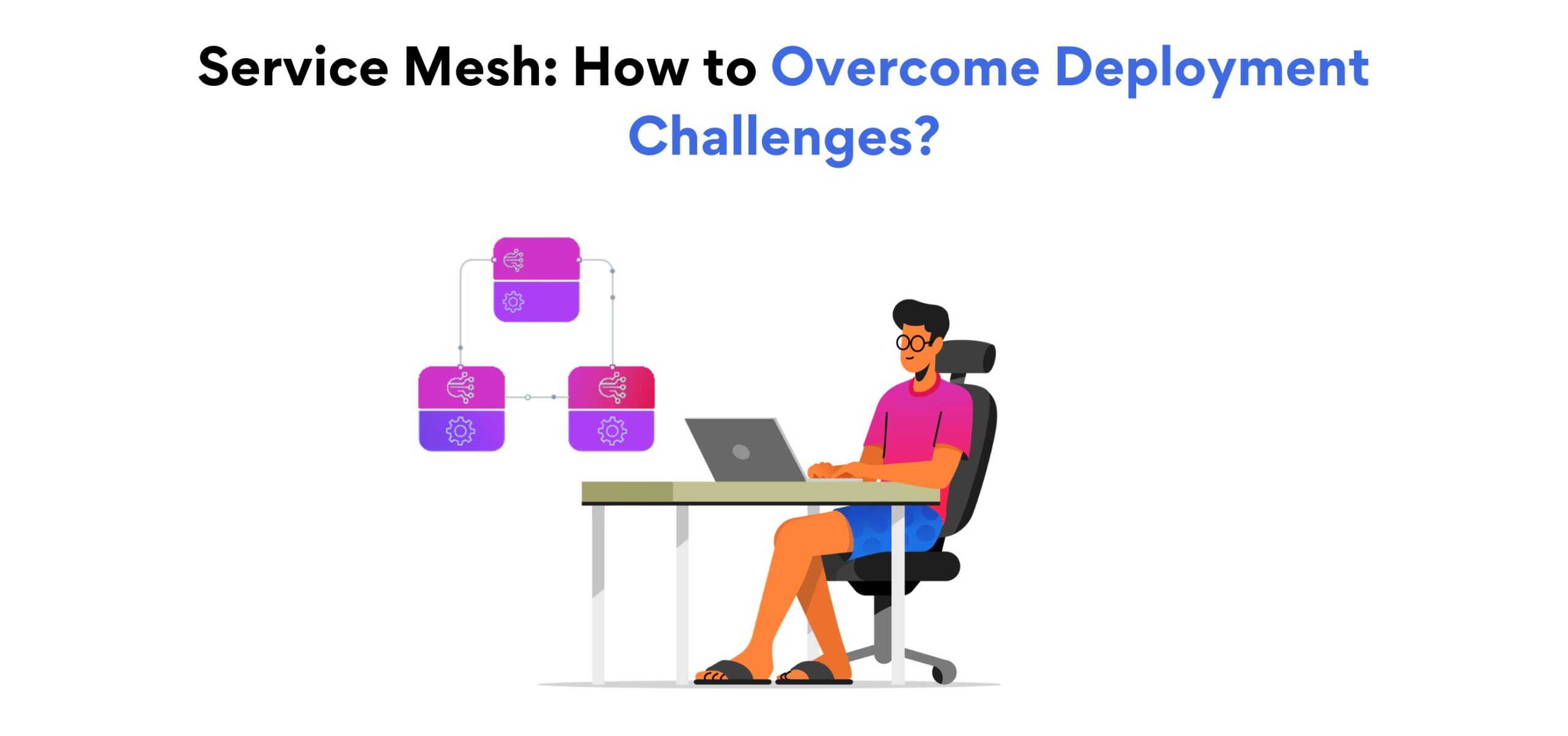Service Mesh: How to Overcome Deployment Challenges?
A service mesh is a configurable infrastructure layer for microservices applications that makes communication between service instances flexible, reliable, and fast. It provides features such as traffic management, service discovery, load balancing, failure recovery, and security between microservices. A service mesh operates at the application layer and manages communication between service instances in a distributed architecture, freeing developers from writing repetitive, low-level infrastructure code.
Also, read: What are Microservices? Understanding Architecture, Examples, and Best Practices for 2023
What are the benefits of using service mesh?
The benefits of using a service mesh include the following:
- Improved reliability: A service mesh provides features like automatic retries, circuit breaking, and traffic management to improve the reliability of microservice communication.
- Increased security: A service mesh can enforce security policies, such as encryption and authentication, between microservices.
- Better observability: A service mesh provides a unified view of traffic between microservices, allowing for easier debugging and performance analysis.
- Decoupled evolution: The service mesh abstracts communication between microservices, allowing individual microservices to evolve independently.
- Reduced complexity: A service mesh reduces the complexity of microservice communication by centralizing standard functionality, such as load balancing and traffic management, into a standard infrastructure layer.
- Easy to adopt: Service mesh implementation is usually transparent to the application and can be adopted gradually, minimizing the impact on existing microservices.
Also, read: 8 Microservices Data Management Patterns
What are the major challenges faced by the DevOps teams while deploying a service mesh?
The deployment of a service mesh can face several challenges, including:
- Complexity: Service mesh can add complexity to an application, especially if the team is not familiar with the technology and its concepts.
- Performance overhead: Service mesh can introduce additional latency and overhead due to the added layer of abstraction between microservices.
- Integration with existing infrastructure: Service mesh needs to be integrated with existing infrastructure, such as load balancers, proxies, and firewalls, which can be challenging and time-consuming.
- Skills and knowledge: Deploying and managing a service mesh requires a specialized set of skills and knowledge, which may not be available within the DevOps team.
- Security considerations: Service mesh can bring security benefits, but it also introduces new security considerations, such as the management of encryption keys and access control.
- Testing and validation: Service mesh can affect the behavior of microservices, requiring additional testing and validation to ensure that the application continues to function as expected.
- Compatibility: Service mesh may not be compatible with all microservices and technologies, and may require significant modifications to be integrated successfully.
Overall, deploying a service mesh requires careful planning, testing, and consideration of the potential challenges to ensure a successful implementation.
Also, read: 4 Reasons to Learn DevOps in 2023
So, how can you deploy service mesh without the hassle?
Here are some best practices for deploying a service mesh without the hassle:
- Plan ahead: Plan the deployment of the service mesh carefully, taking into account the size and complexity of the application, the available resources, and the team’s skills and knowledge.
- Start small: Start with a small, simple deployment, and gradually increase the scope and complexity as the team becomes more familiar with the technology.
- Evaluate different solutions: Evaluate different service mesh solutions to find the best fit for the application, taking into account features, performance, compatibility, and security considerations.
- Integrate with existing infrastructure: Integrate the service mesh with existing infrastructure, such as load balancers, proxies, and firewalls, to ensure seamless integration and minimize the impact on the application.
- Automate deployment and management: Automate the deployment and management of the service mesh to reduce the overhead and improve efficiency.
- Foster a culture of collaboration: Foster a culture of collaboration between the DevOps and security teams to ensure that security considerations are taken into account throughout the deployment process.
- Continuously monitor and optimize: Continuously monitor the performance of the service mesh and make optimizations as necessary to ensure that the application continues to perform well.
By following these best practices, teams can deploy a service mesh more smoothly, reducing the risk of issues and ensuring a successful implementation.
Benefits of using Configuration-as-Code in a GitOps approach
Using Configuration-as-Code (CAC) in a GitOps approach for service mesh deployment has several benefits:
- Reproducibility: CAC makes it easier to recreate the service mesh configuration, making it easier to test, debug, and deploy the service mesh.
- Version control: CAC allows for version control of the service mesh configuration, enabling teams to track changes over time and revert to previous versions if necessary.
- Collaboration: CAC enables collaboration between members of the DevOps team, making it easier to share and review changes to the service mesh configuration.
- Automation: CAC allows for the automation of the deployment process, reducing the risk of human error and improving the efficiency of the deployment process.
- Better alignment with DevOps workflows: CAC aligns with the GitOps approach, which is a popular DevOps workflow that leverages Git for version control, collaboration, and automation.
- Enforces consistency: CAC enforces a consistent configuration for the service mesh, reducing the risk of configuration drift and ensuring that the service mesh behaves as expected.
In conclusion, using CAC in a GitOps approach for service mesh deployment provides teams with a powerful tool for improving the efficiency, reliability, and consistency of the deployment process.
Also, read: 6 DevOps Best Practices to Know in 2023
How can you lower the cost of service mesh deployment by using Low-Cost Cloud CPUs?
Using low-cost cloud CPUs can help to reduce the cost of service mesh deployment in the following ways:
- Economies of scale: Cloud providers such as Amazon Web Services (AWS), Google Cloud, and Microsoft Azure offer a wide range of low-cost cloud CPUs, taking advantage of economies of scale.
- Pay-as-you-go pricing: Most cloud providers offer pay-as-you-go pricing, which allows you to only pay for the resources you use, without having to make any upfront investments.
- Spot instances: Cloud providers offer spot instances, which are spare computing capacity offered at a discounted rate, enabling you to save money on compute costs.
- Right-sizing instances: By choosing the right instance type based on the resource requirements of the service mesh components, you can avoid over-provisioning and reduce costs.
- Cost optimization tools: Many cloud providers offer cost optimization tools that can help you monitor and control your costs, making it easier to manage the cost of deploying a service mesh.
In conclusion, by taking advantage of low-cost cloud CPUs, teams can reduce the cost of deploying a service mesh, making it more affordable and accessible for organizations of all sizes.
What should you consider while choosing the control plane for Service Mesh?
When choosing a control plane for deploying a service mesh, there are several key factors to consider:
- Compatibility: Make sure that the control plane is compatible with your service mesh technology and supports the features you need.
- Ease of use: Choose a control plane that is intuitive and easy to use, to minimize the learning curve and reduce the time required for deployment.
- Automation: Look for a control plane that automates as much of the deployment process as possible, reducing the risk of human error and improving the efficiency of the deployment.
- Scalability: Consider the scalability of the control plane, to ensure that it can support your growing service mesh deployment.
- Cost: Consider the cost of the control plane, including any licensing fees, and make sure it fits within your budget.
- Support: Ensure that the control plane is backed by a reliable support team, to help you resolve any issues that may arise during deployment.
- Integration with other tools: Consider the integration capabilities of the control plane, to ensure that it integrates with other tools and services you are using.
In conclusion, by carefully considering these factors, you can choose the right control plane for deploying your service mesh, improving the efficiency, reliability, and cost-effectiveness of the deployment process.
To summarize: Deploying service mesh is a complex process but can provide significant benefits
Service mesh offers a plethora of benefits such as improved reliability, scalability, and security. The complexity of the deployment does make it a challenging process. But, by using Configuration-as-Code in GitOps, choosing the right control plane, and ensuring a positive experience for developers, one can overcome the challenges of deploying a service mesh.
Are you a software developer looking for a remote DevOps job? Try Turing! Get hired by top US companies and get paid in dollars while working from the comfort of your home.
Join a network of the world's best developers and get long-term remote software jobs with better compensation and career growth.












